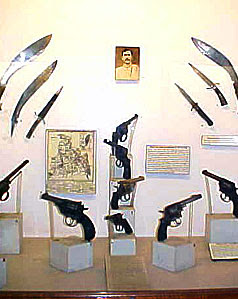 |
| Kolkata Police Museum |
Whether you have only a few minutes or an hour or two, enjoy a delightful visit to the Kolkata Police Museum. Occupying 2,000 square feet, the Museum reflects the rich tradition and history of policing in our city.
The Museum seeks to collect, preserve and interpret objects related to the history of Kolkata Police. Our exhibit includes various items seized during the freedom struggle of the country.
 |
| Kolkata Police Museum |
The 2,000 square feet Kolkata Police Museum on Acharya Prafulla Chandra Roy Road is housed inside one of Raja Ram Mohan Roy’s personal mansions with wooden staircases and Corinthian pillars. Earlier devoted to three galleries, it now has eight galleries showcasing memorabilia of the police force depicting the evolution of the law-keeping body right from the conception of the city in the 1600s to its present day metropolitan standing.
 |
| One of the displays |
Nationality, authority and allegiances :
Inside another enclosure there is a six-chamber Webley revolver recovered from the young nationalist Jogendradas Bhattacharjee during the Pathuriaghata Street raid, iron and brass bomb shells, and a broken car door of British officer Charles Tegart whose vehicle they had been thrown at. Pathuriaghata Street was a safe hub for the young revolutionaries of Bengal during 1916-17.
The sensation of blood-curdling mutiny and a consequent excitement produced by such a national past is immediately defused by a very poignant letter written by revolutionary Dinesh Gupta (of the Binay-Badal-Dinesh nationalist trio, in honour of whom Kolkata has a square dedicated) to his mother and sister while he was in jail waiting to be hanged.
The Kolkata Police as an institution has an intriguing history. Once bearing allegiances to the British, seen in retrospect, the institution had its duty to safeguard the interests of the colonisers. After 1947, the police became an autonomous unit of the country serving its people that had once launched several attacks on Indian officers in a force reporting to their British superiors.
As one goes through the galleries, a queer-looking aluminium bomb comes up on display. It had been used to launch an attack on Charles Tegart, the Commissioner of Calcutta Police in 1930.
 |
| The broken car door of British officer Charles Tegart |
Next to it there’s a photograph of Surendra Nath Chatterjee, the first Commissioner of Calcutta Police post-Independence. It is strange to contemplate the fact that young Surendra Nath’s father, Basanta Chatterjee was a Deputy Superintendent under British India who had lost his life to mob violence by the nationalists. His bodyguard too was killed in the attack. When the government had changed, his son became a public servant of the very same citizens who had killed his father. This evolution of the institution over the ages can cause one to reflect on the notions of nationality, authority and allegiances.
 |
| The Netaji files |
Not just for museum-enthusiasts :
Could there be fear or doubt among people regarding a museum preserved by the Police because of which individuals, especially museum enthusiasts, visit the place in really small numbers? The majority of tourists that the museum attracts is among those on school or college trips or brought to the place in groups by government based tourist organisations.
However the two storey museum housed inside this fine piece of heritage architecture on Acharya Prafulla Chandra Roy Road, is one of the most modernized and state of the art facilities. For instance, Kolkata Police – in charge of maintaining the museum – has planned to install audiometric device for each gallery, the installation of which remove necessities of manual guidance and provide a technical roundup of the requisite information one needs to have about each section.
The Kolkata Police Museum is a true delight for any history enthusiast, student or museum-freak. It receives little exposure due to lack of a central location unlike the more popular museums of Kolkata but hidden in the northern corners of the city, it is like one of those little-known heritage gems that lose out to the ever-speeding pace of life in the city. However connoisseurs of all things old shall have an assuredly delightful time here.










No comments:
Post a Comment